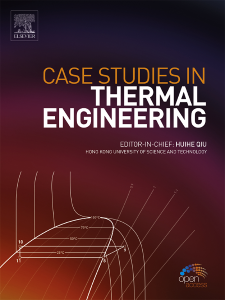壳管式 PCM 储能装置的散热特性和能耗研究
IF 6.4
2区 工程技术
Q1 THERMODYNAMICS
引用次数: 0
摘要
壳管式 PCM 储能装置用于冷藏设备,其散热过程是影响其性能的关键因素。本研究通过实验和数值模拟研究了冷却水温度、水流速度和管子形状对壳管式 PCM 储能装置散热过程的影响。根据冷却器和水泵的能耗分析了能量性能。结果表明,螺旋管的热去除率最高,阻力损失最大,但冷却器的能耗也最低。此外,研究还发现,冷却水温度每升高 1°C,排热时间就会增加约 13.9%,能效比 (EER) 降低约 9.5%,冷水机能耗降低约 5%。较高的冷却水流速可以提高热量去除率,但会降低能效比。除管子形状外,冷却水温度和流速都会影响外壳内 PCM 液体的分布,从而影响固态 PCM 显热去除过程中的能耗。与液态和混合态相比,固态 PCM 显热去除过程的 EER 较低。本文章由计算机程序翻译,如有差异,请以英文原文为准。
Study of heat removal characteristics and energy consumption of shell-tube PCM energy storage units
Shell-tube PCM energy storage units are used in cold storage devices, the heat removal process is a critical factor influencing their performance. This study investigates the effects of cooling water temperature, water velocity, and tube shape on the heat removal process of shell-tube PCM energy storage units through both experiments and numerical simulations. The energy performance was analyzed based on the energy consumption of the chiller and water pump. The results show that the spiral tube has the highest heat removal rate and the greatest resistance loss, but also the lowest chiller energy consumption. Additionally, the study found that for every 1 °C increase in cooling water temperature, the heat removal time increases by approximately 13.9 %, the energy efficiency ratio (EER) decreases by about 9.5 %, and the chiller energy consumption decreases by about 5 %. Higher cooling water velocity can improve the heat removal rate but reduces the EER. Beyond tube shape, both the cooling water temperature and velocity affect the PCM liquid fraction distribution inside the shell, thereby influencing the energy consumption during the sensible heat removal of solid-state PCM. The EER of the sensible heat removal process for solid-state PCM is lower compared to that of liquid and hybrid states.
求助全文
通过发布文献求助,成功后即可免费获取论文全文。
去求助
来源期刊

Case Studies in Thermal Engineering
Chemical Engineering-Fluid Flow and Transfer Processes
CiteScore
8.60
自引率
11.80%
发文量
812
审稿时长
76 days
期刊介绍:
Case Studies in Thermal Engineering provides a forum for the rapid publication of short, structured Case Studies in Thermal Engineering and related Short Communications. It provides an essential compendium of case studies for researchers and practitioners in the field of thermal engineering and others who are interested in aspects of thermal engineering cases that could affect other engineering processes. The journal not only publishes new and novel case studies, but also provides a forum for the publication of high quality descriptions of classic thermal engineering problems. The scope of the journal includes case studies of thermal engineering problems in components, devices and systems using existing experimental and numerical techniques in the areas of mechanical, aerospace, chemical, medical, thermal management for electronics, heat exchangers, regeneration, solar thermal energy, thermal storage, building energy conservation, and power generation. Case studies of thermal problems in other areas will also be considered.
 求助内容:
求助内容: 应助结果提醒方式:
应助结果提醒方式:


